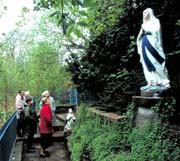Story of a 20th century shrine
 |
 |
 |
‘Oh yes, people still come. We often see total strangers here. They might leave some flowers, then they go.’ |
80 years ago a small community of Irish miners at Abercynon in South Wales built a shrine to the Virgin Mary at a place where two rivers met, black with coal washed down from the workings upstream.
The bank sloped down steeply to the river below, and as they cleared the land and built on it, they discovered two springs of clean water just above the level of the blackened and polluted river.
Dreaming of a Welsh Lourdes they built wells to hold the spring water, and enshrined a statue of the Virgin Mary above them. A winding path and steps led from the top of the bank down to the wells on the river’s edge, and Stations of the Cross (scenes from the last journey of Jesus through Jerusalem to his crucifixion) were set along the way.
 |
| One day, with the help of a new generation and a wider community, the shrine and its river bank at Abercynon will bloom into new life |
|
 |
 |
Rumours of healings at the shrine spread. People arrived in coach-loads from all over South Wales. Processions carried the Blessed Sacrament to the wells while girls scattered flowers along the path.
‘This place was our whole life,’ recalls Theresa, who lived nearby as a young girl.
Today the statue of Mary still overlooks the waters of the Cynon, now free of the coal-dust which clogged them 80 years ago. But the path is crumbling and the rusting gates are locked. No trace remains of the wells, washed away by winter floods.
Yet in Mary’s hands are sometimes found a posy of flowers.
‘Oh yes, people still come,’ says Theresa. ‘Not just parishioners. We often see total strangers here. They might leave some flowers, then they go.’
‘If I’m there alone I feel as if there were a hundred people with me,’ says her friend Tessa.
‘A while ago a man came from Cardiff and spent long hours at the weekends repairing the path. He said he had made a promise to the Virgin, and this was its fulfilment.’
This sense that a sacred site is never really lost underpins what the Sacred Land Project is all about. There is something special about a place where a community has prayed.
Perhaps a valuable habitat has been preserved by the locked gates and a new sort of sanctuary created. One day, with the help of a new generation and a wider community, the shrine and its river bank at Abercynon will bloom into new life.
|

